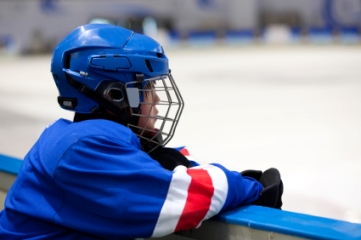To provide maximum protection against head injuries, helmets worn by athletes in contact sports such as youth hockey and lacrosse, need to fit correctly, but a new study finds that fewer than four in ten youth hockey and lacrosse helmets are properly fitted. (Williams, 2014).
Investigating helmet fit and knowledge among a group of athletes age 8 to 14 years playing boys' lacrosse and ice hockey, researchers found there was a significant gap between helmet knowledge and helmet fit: while 70% of the players answered all knowledge questions correctly - with all answering at least 3 out of 4 questions correctly - only 42% of lacrosse players' helmets and 30% of hockey players' helmets passed a standardized, sport-specific helmet fit checklist.

The most common fit problems, researchers found, related to facemasks slipping, chin strap tightness, and fit of the helmet above the eyebrows. Lack of understanding about the importance of having one's helmet checked, as well as knowledge of how tightly the helmet should fit, were the most common misconceptions players had about helmet fit.
The results suggest the "need for better fit helmet training and education in youth ice hockey and lacrosse players," wrote Johna Register-Mihalik, a concussion injury researcher at the University of North Carolina at Chapel Hill, member of MomsTEAM Institute's Board of Advisors, and a co-author of the study, published online in the journal Athletic Training & Sports Health Care.
Recommendations
To increase the likelihood that athletes in helmeted sports such as hockey, lacrosse, and football, will wear their helmets properly, the authors (who also included Tamara Valovich McLeod, chair of the athletic training department at A.T. Still University in Mesa, Arizona, and a coordinator of one of six pilot programs in MomsTEAM Institute's SmartTeam program), made the following recommendations:
- Frequent and regular helmet fit checks. Helmet fit should be assessed regularly and frequently to account for changes in the child's size and wearing conditions (e.g. wet versus dry hair, long hair versus short) and ensure that the helmet is properly fitted and worn each time the player participates.
- Player notification when helmets don't fit. When possible, players should make sure that they understand the way the helmet should fit and let the correct personnel know if they need more air, tighter chin straps, or a better fitting helmets. For younger athletes, parents and coaches should be continuously mindful about fit and wear of the helmet.
- More parent, coach training on proper helmet fitting, particularly at youth level. Parents, coaches, equipment manager, and medical personnel should be familiar with the helmet and should have access to training on proper helmet fitting. At the youth level, equipment managers are usually not available to manage equipment, and parents often oversee the fitting of protective equipment in this age group. As a result, education needs to be widely and easily accessible for parents, players, and coaches concerning helmets. Educational programs should not only focus on recognizing signs and symptoms of concussion and other head trauma, but should also include information on helmet condition and fit.
Helmets don't prevent concussions
Helmet fit is important, experts say, because, when worn properly, they can prevent catastrophic injuries such as skull fractures and dissipate some but not all the forces that cause concussions, potentially reducing their severity. In June 2014, the National Operating Committee on Standards for Athletic Equipment (NOCSAE) voted to adopt a revised standard for football helmets which will, when implemented in 2016, require helmets to limit concussion-causing forces, both linear and rotational.
While the much-ballyhooed Viginia Tech's 'STAR' football helmet ratings suggest that some helmets to a better job than others at reducing concussion risk, a 2014 study of high school football players suggest that concussion risk is not affected by helmet brand, age, reconditioning history, or even helmet fit.Helmet fitting resources
As no validated checklists currently exist in the literature, researchers consulted with 2 helmet and protective equipment content experts to design checklists designed around basic helmet fit guidelines for youth lacrosse and youth hockey.
For the youth hockey helmet checklist, click here.
For the youth lacrosse helmet checklist, click here.
Sources:
Williams RM, Valovich McLeod TC, Register-Mihalik JK, Mihalik JP, Marshall SW, Linnan LA, Guskiewicz KM. Ath Tr & Sports Health Care. 2014;6(5):206-212,








